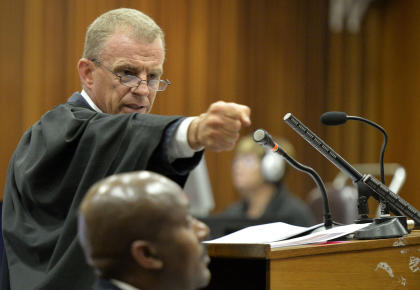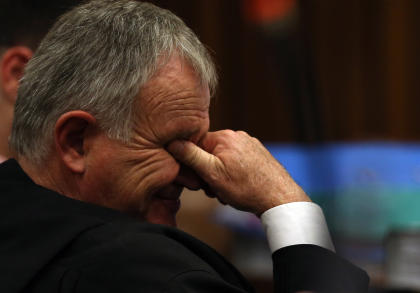Oscar Pistorius murder trial: Key questions heading into closing arguments

PRETORIA, South Africa – After 39 court days over five months, dozens of witnesses, a month of psychiatric evaluation, tears, shouts and accusations, we're nearing the final stretch of Oscar Pistorius' murder trial by all accounts.
The Paralympian will return to the dock in Pretoria's High Court Thursday to listen to the final arguments, courtesy of two of South Africa's top attorneys: defense lawyer Barry Roux and state prosecutor "Bull Terrier" Gerrie Nel.
Judge Thokozile Masipa has already received fat folders of written arguments from both sides, but this will be the only opportunity for them to argue their version of events directly in front of the stern lady herself.

Accused of the murder of his girlfriend Reeva Steenkamp in the pre-dawn hours of Valentine's Day 2013, the star athlete maintains he fired his 9mm through the door of his toilet cubicle in an attempt to protect them both, believing her to be an intruder.
The pages of the court record already numbers in the thousands, but in the adjournment silence, public speculation appears to have superseded the evidence.
Here, we attempt to untangle conjecture from fact.
Is he guilty?
Pistorius has admitted to shooting someone through a closed toilet door, so Judge Masipa must not decide if he is guilty, but what he is guilty of.
The prosecution says it was pre-meditated murder; that the athlete knew he was shooting at Steenkamp, and intended to kill her. Under South African law, that carries a mandatory life sentence – in practice, about 25 years in prison.
The defense says it was a tragic accident, something more akin to "culpable homicide" – a charge similar to manslaughter in the United States – that the double amputee was trying to defend himself and his girlfriend against a perceived threat. Culpable homicide carries no mandatory custodial sentence, although it would be unusual that the perpetrator of an incident of this nature would face no prison time.
There are several other options in between. Pistorius could still be found guilty of murder with a sort of lesser intent: dolus indirectus (where he shot to kill, but without the direct intent to kill Steenkamp) or dolus eventualis (where he understood his actions could cause someone's death, yet recklessly proceeded anyway). Both carry a mandatory minimum 15-year prison sentence.
Both sides agree on several things

There are several points of "common cause" between the prosecution and defense. They agree that:
• Pistorius fired four shots from his 9mm Taurus pistol, which killed Steenkamp;
• The athlete was on his stumps – not wearing his prostheses – when he fired his gun through the door; and,
• The blows of the cricket bat came only after the bullets.
None of those agreed facts disprove Pistorius' version of events, nor do they prove the state's charges of premeditated murder.
So, did he know it was her?
Prosecutor Nel, nicknamed "Bull Terrier" for his unrelenting style of interrogation, appears to have taken two approaches in his questioning of witnesses and Pistorius. Nel has alternated his focus between the murder-accused's intent when he fired his gun, and trying to show that, in all probability, the star athlete knew it was his girlfriend in the toilet.
For each point scored by the prosecutor, the defense has had a response.
• Neighbors said they heard a woman scream.
Pistorius says he never heard Steenkamp scream, so he didn't know she was the person in the bathroom. However, the state's witnesses insist they heard the "terrified," "bloodcurdling" screams of a woman. The defense's witnesses, who live closer, heard a man.
A defense sound expert testified that it would have been "near impossible" for several state witnesses to have heard screams, let alone determine their gender. The prosecution pointed out that exact conditions could not be replicated in tests.
One state witness, Estelle van der Merwe, testified that she had heard "voices, like people arguing" in the hours before the shooting. Under cross-examination, she admitted she could not be sure of the origin of the sound.
Ultimately, the timeline of neighbors' calls to security and the two sets of "bangs" – as submitted to the court in evidence, and shared with Yahoo Sports – tallies with Pistorius' version of events.
• Why didn't Pistorius make sure of Steenkamp's whereabouts when he believed there to be a threat?

Pistorius testified that he had just spoken with his girlfriend in bed only moments before, when he woke up and went to move two fans into the bedroom, in order to close the balcony door. The athlete says he was on the other side of the room when he heard the sound of his bathroom door sliding open, at which point he whispered to her, asking her to call the police while he went to investigate. He did not confirm that she heard him.
• Why was Steenkamp locked in the toilet cubicle when she was shot?
The state says Steenkamp ran from a furious Pistorius after an argument. Terrified and trying to escape his wrath, she locked herself in the toilet with her iPhone.
The defense says she was in the bathroom already with her iPhone as the lights weren't working, and locked herself in for protection after hearing her boyfriend shout at an intruder.
• Why didn't Steenkamp respond to Pistorius' shouts?
The state says Steenkamp was scared of Pistorius.
The defense has suggested that Steenkamp was scared of Pistorius' perceived intruder, so she hid in silence, despite his approaching shouts.
Forensic experts from both sides disagree on her position when the first shots were fired. Defense experts say it's likely she was about to open the door and come out, while the police's ballistic expert says she was cowering.
• But he shot her four times. Wouldn't she have screamed, so he must have known it was her?
The state pathologist says she would have likely screamed after the first shot.
Defense forensic experts say the shots were likely in fairly rapid succession, given the location of the bullet holes. Pistorius says his ears were ringing after the first shot, suggesting that he may not have heard anything beyond his gun.
• But Steenkamp's stomach contents show she may have eaten later than Pistorius said they did. Doesn't that mean he's lying?
While Gert Saayman, the state pathologist who conducted Steenkamp's autopsy, says she could have eaten as few as two hours prior to her death, both he and defense forensic experts have emphasized that this is an "inexact science."
• According to police photographs, things couldn't be where Pistorius said they were, if his account of events is true.
In his testimony, Pistorius was unequivocal about the placement of several objects: he said the magazine rack was in a corner on the other side of the toilet cubicle from where Steenkamp was shot, and that his bedspread was on the bed when he went to the bathroom.
Police photographs of the scene show dried blood pooled around a shape, which appears to be a foot of the magazine rack, next to where Steenkamp would have collapsed, and a defense expert confirmed this. Photographs also show blood spatter on Pistorius' bed covers, resting on the floor, suggesting it was there when he carried his bleeding girlfriend past.
The defense says police officers could have moved items at the scene, and that blood spatter on the bedspread could have occurred while it was on the bed, before it was moved to the floor.
Defense vs. prosecution: Who's winning?

On the stand, Pistorius' testimony over seven days was patchy: emotional and seemingly sincere, but occasionally inconsistent and forgetful. The murder-accused often appeared to be confusing his memory of what happened in the early hours of Valentine's Day, and what he surmised after.
Yet, the prosecution did not manage to show anything definitive that proved his detailed account of events to be untrue.
Prosecutor Nel said early on in the trial, that they would contend the second set of "bangs" that neighbors heard were the gunshots, but have yet to give their version of what the first set of "bangs" were – something presumably more difficult now that forensic experts from both sides have agreed the shots came before the cricket bat.
The state is basing its argument for "pre-meditated murder" on improbability – that Pistorius' version is so unlikely, it must be untrue.
Ultimately, Judge Masipa must choose which version of events she believes.
And while Pistorius' version of events may have not been concretely discredited, it doesn't mean he's off the hook.
Even if he didn't know it was her, he still shot someone
Although much public speculation has revolved around whether Pistorius meant to shoot his girlfriend, fundamentally, he will have to face judgment on the fact that he shot and killed someone.
The defense team's strategy to avoid a murder conviction – pushing instead for "culpable homicide" – has centered on the principle of "putative self defense", which allows someone to shoot if they genuinely perceive a mortal threat, even if objectively, there isn't one, and believe they have no other option.
Much hinges on Pistorius' state of mind when he fired those four shots.
His defense has presented two main arguments about this.
First, their star witness testified that the Paralympian, who had a heightened awareness of crime, was in "fight or flight" mode and wasn't carefully considering his every action. Rather, he acted instinctively, controlled by his subconscious brain, implying a lack of true intent. Prosecutor Nel was incredulous about this, pointing out that Pistorius' movements – carefully approaching the bathroom, choosing not to shoot a warning shot in case it might ricochet, bracing his back against the wall to deal with gun recoil – showed rational thought.
Second, the defense has gone to lengths to paint a picture of "Two Oscars": one, a confident gold medalist, never wanting to be defined by disability, a global icon, triumphing over adversity; the other, a terrified double amputee with a tragic childhood, who was raised to be fearful, hiding his vulnerability from the world. Can a man with no legs be judged by the same standards of what is reasonable for an able-bodied person?
The defense has suggested that – believing he was unable to run away, spurred by anxiety emerging from a lifetime of disability – Pistorius fired because he feared for his life. It is a compelling argument, and one which could lead to a precedent-setting judgment.
The prosecution – and a prominent local disability activist group – have argued that the Paralympian, who fought to be regarded as able-bodied, can't argue vulnerability on the basis of his disability, when he has spent his life demonstrating how he overcomes it.
What happens now?
After two days of oral arguments, court will adjourn for Judge Masipa, assisted by her two assessors, to consider her verdict. The assessors – who can also overrule her if they both vote differently – will help Masipa write her lengthy judgment, which she will read out in court when the trial reconvenes.
There has been much speculation about the length of time she will take to deliberate – potentially between a week to two months. The reading of the judgment itself could take some time, especially given the scrutiny the trial has attracted, and the need to appear thorough – the bail hearing judgment took over an hour.
Court will then adjourn again, before reconvening for a sentencing hearing, during which both sides are able to present arguments about the severity of the punishment, and whether it should be mitigated, before the judge then retires to consider the sentence she will hand down. Only when court resumes after that break, will Pistorius know his fate.

 Yahoo Sports
Yahoo Sports 